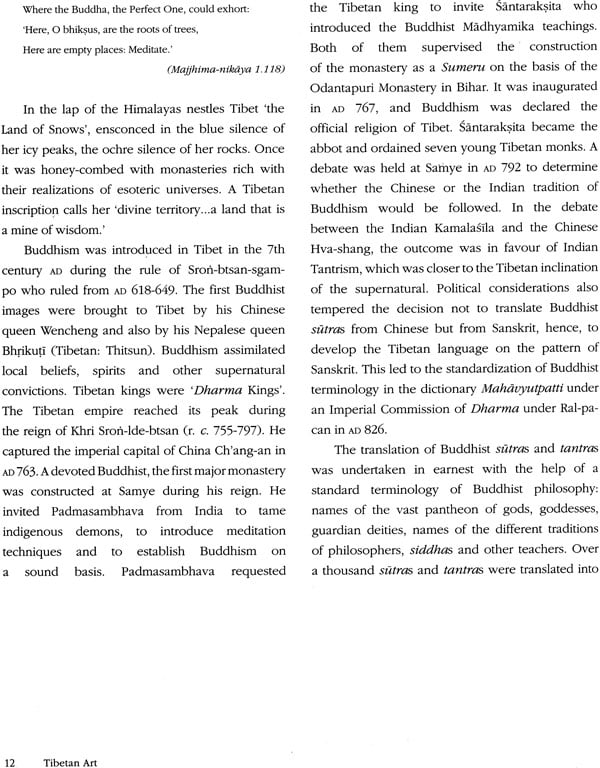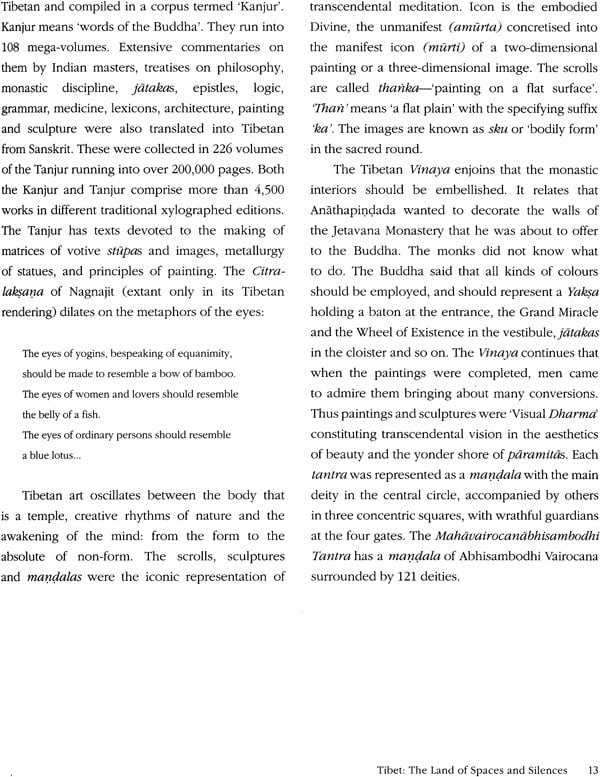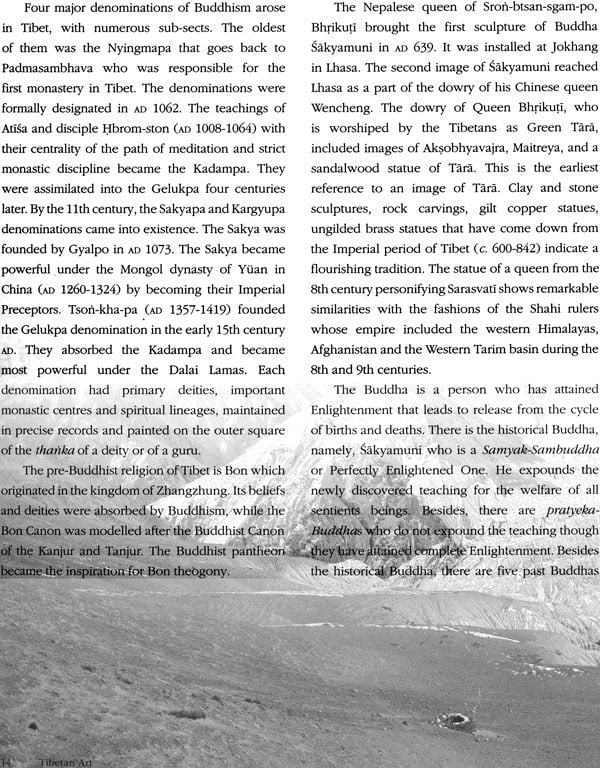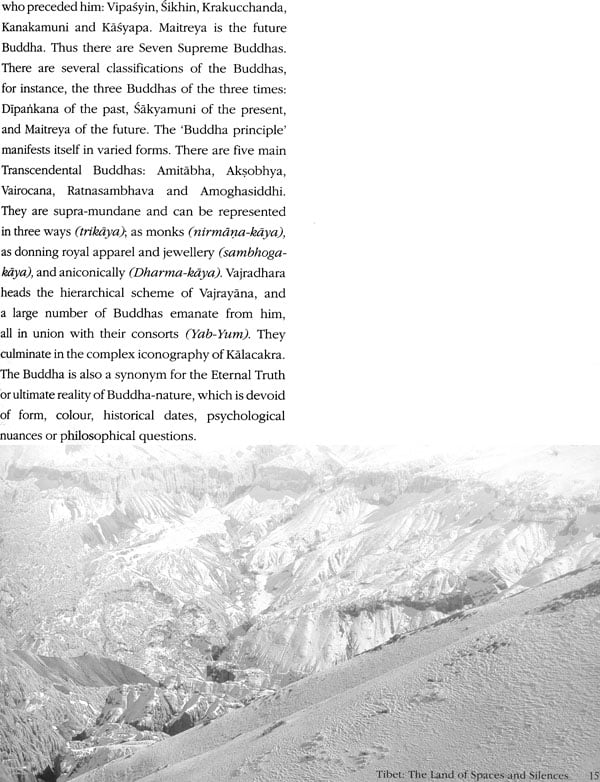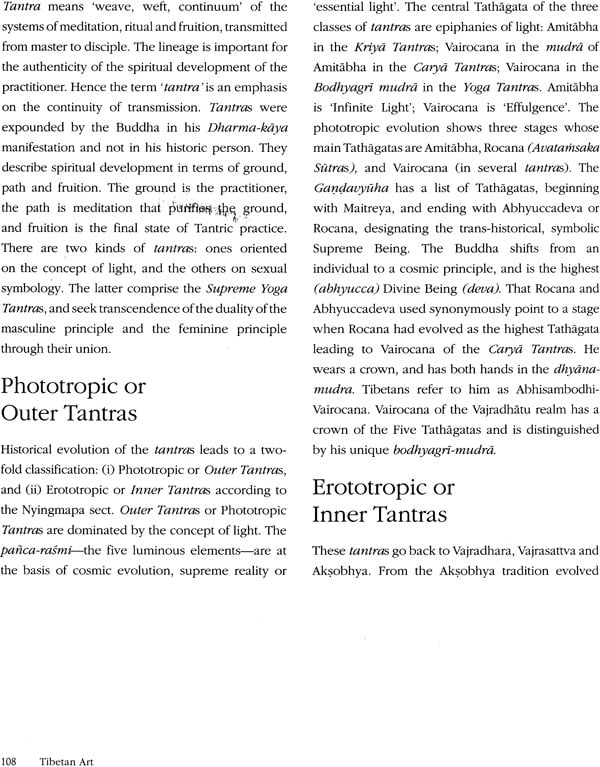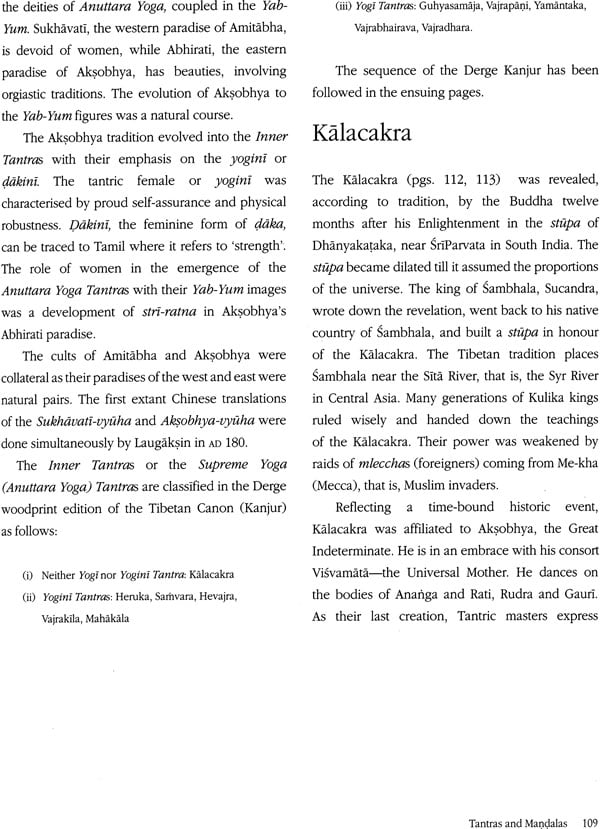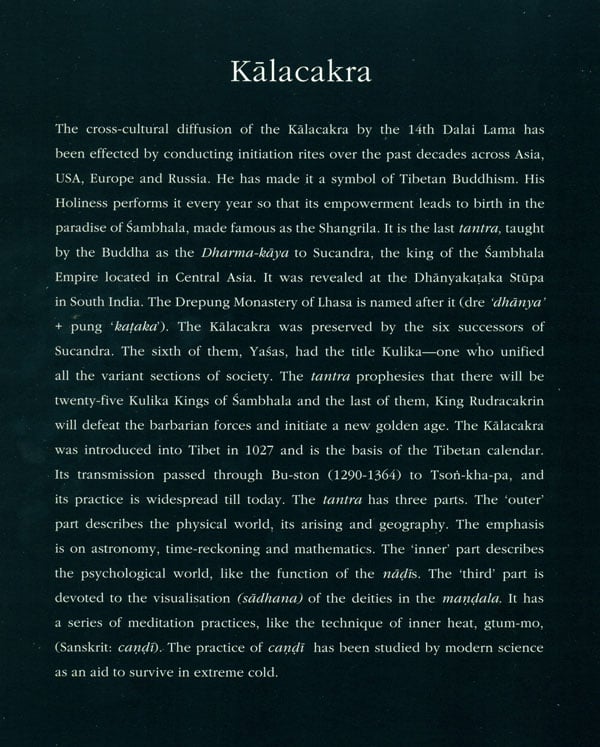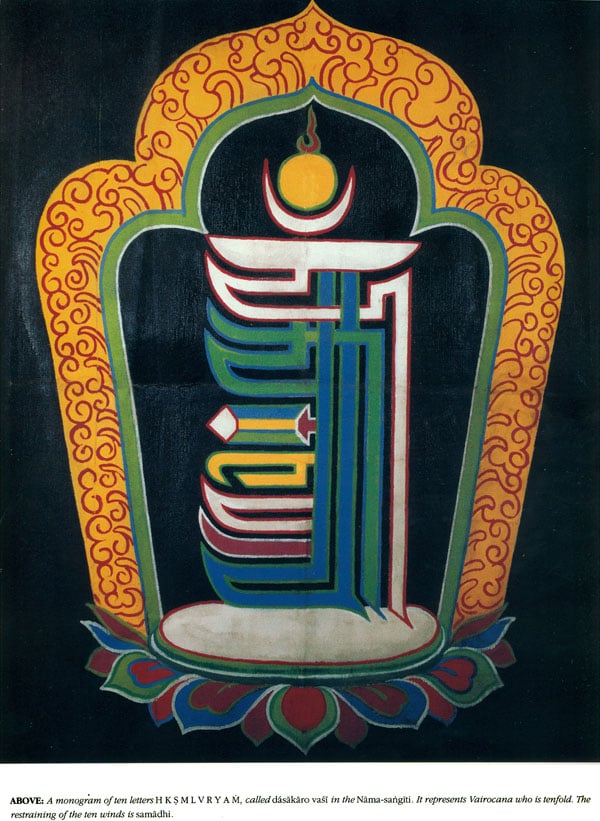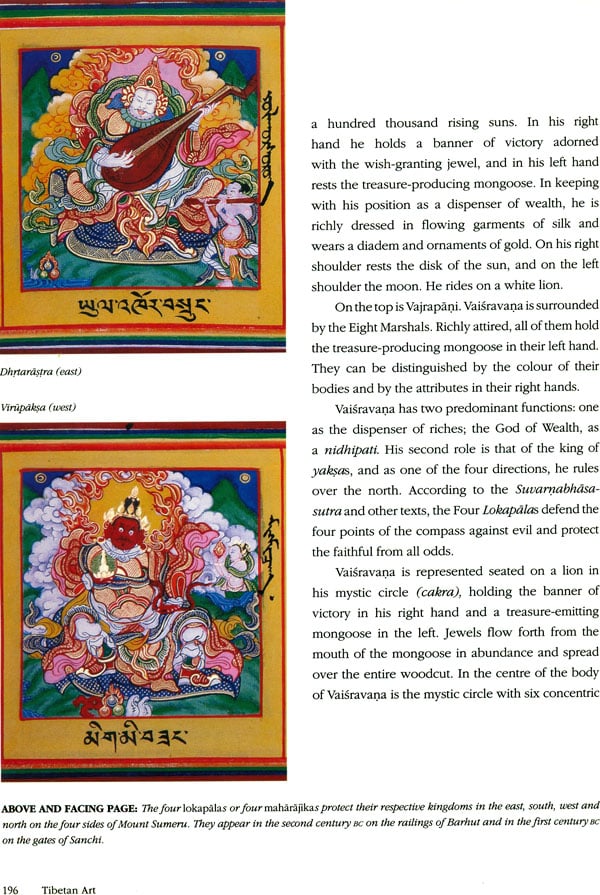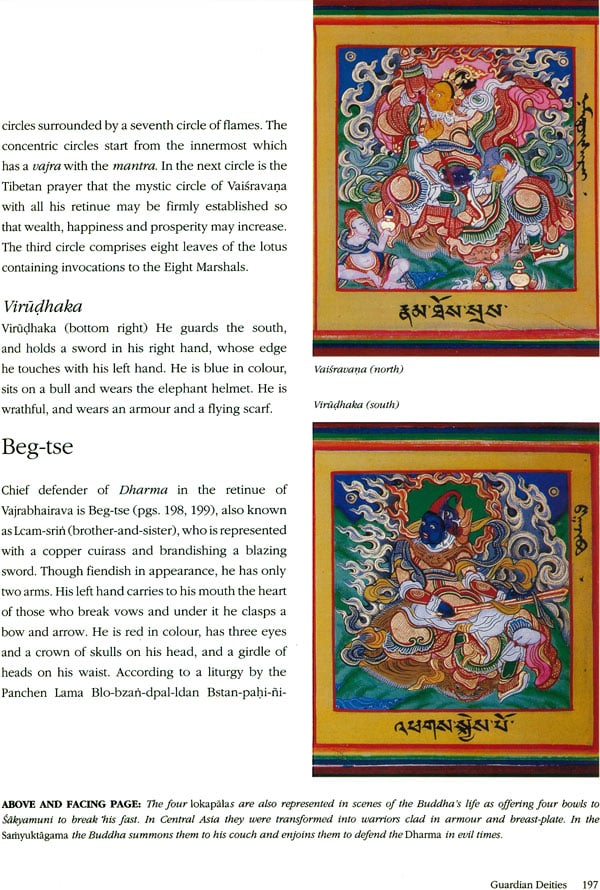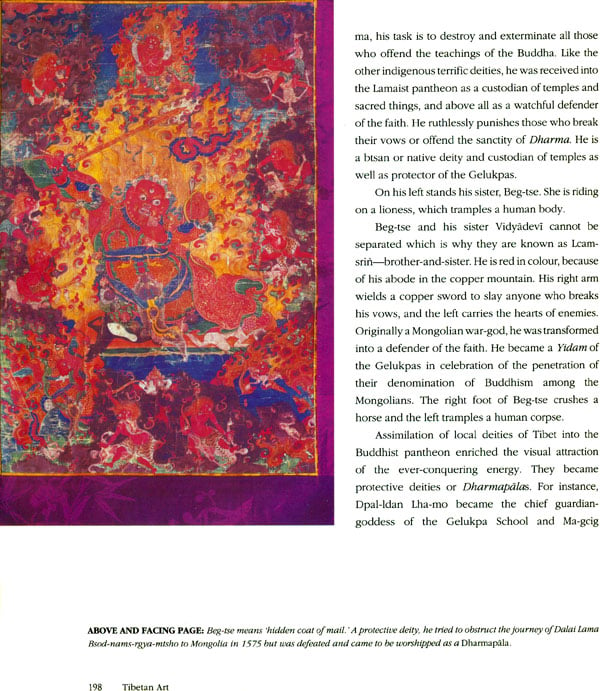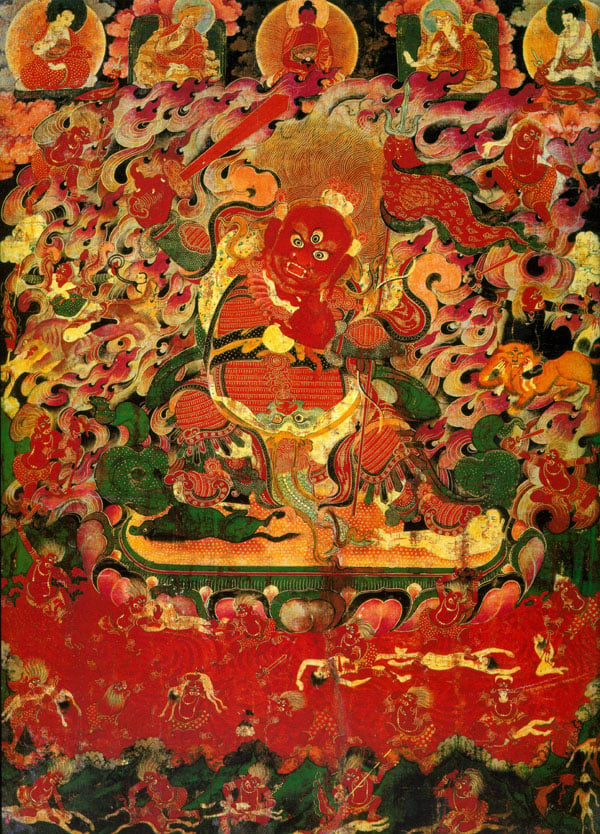
Tibetan Art
Book Specification
| Item Code: | IDC183 |
| Author: | Lokesh Chandra |
| Publisher: | Niyogi Books |
| Language: | English |
| Edition: | 2012 |
| ISBN: | 9788189738303 |
| Pages: | 216 (Illustrated Throughout In Full Color) |
| Cover: | Hardcover |
| Other Details | 12.5" X 9.8" |
| Weight | 1.70 kg |
Book Description
From the Jacket
The rich artistic heritage of Tibet reveals the depths of meditations of great Masters, translated into the majestic abundance of iconic symbols that take the form of three-dimensional images or two-dimensional thankas. Tibetan Art is a comprehensive introduction to the complex iconography of thankas. It provides a glimpse of the mindground of this art and the land where it flourished. Although Tibetan Art portrays the historic Buddha Sakyamuni, the arhats, spiritual masters, great lamas, and founders of different religious lineages, the preponderance of its images depict supramundane being Predominantly these are: the Buddhas, Bodhisattvas, female deities, protectors or tutelary gods (yi-dams), defenders of the faith, guardians of the four cardinal points, minor deities and supernatural beings. The leading gods are also depicted in different forms and manifestations.
Tibetan Art takes the reader on a journey of self-discovery: Buddhist deities do not exist outside ourselves, but represent aspects of innate human potential-the capacity for compassion, wisdom, mental discipline, and other spiritual conditions and achievements, with no distinct, independent existence or objective reality, these deities are but symbols of abstract qualities, that are emanations of the one’s mind, and of the universal mind that venerates perfection.
Lokesh Chandra is an internationally renowned scholar of Tibetan, Mongolian and Sino-Japanese Buddhism. A prolific writer, he has to his credit 580 works, including critical editions of classical texts in Sanskrit, Tibetan, Mongolian, Chinese and old Javamer language. Among them are classics like the Tibetan-Sanskrit Dictionary, Materials for a History of Tibetan Literature, Buddhist Iconography of Tibet, and the Dictionary of Buddhist Iconography in 15 volumes. Lokesh Chandra was nominated by the President of India to the Parliament in 1974-80, and again in 1980-86. He has been Vice-President of the Indian Council for Cultural Relations, and Chairman of the Indian Council for Historical Research. Presently he is Director, International Academy of Indian Culture.
Preface
Even as the Sun ripens the corn and the fruits of the earth, so do the Buddhas, the Enlightened Ones, emit upon samsara the radiances of their all-embracing Wisdom and Compassion, fuelling the growth and maturity of the bodhic essence implanted in all living beings. In course of time, the human Sakyamuni Buddha became a symbol. Nirvana was transformed into paradise, and karma became modifiable by prayer. Elaborate patterns emerged. With metaphysical daring, this Eternal par excellence, definable by negatives alone, became the bejeweled sambhoga-kaya, passionately embracing his transcendental consort (prajna). Extreme serenity was identified with extreme passion, crystal light with the fire of love, the intangible with the intoxication of the sense. Sensuality and symbolism, metaphysical filigree of jewels, the earth and sky were celebrated in thankas, images, mandalas, and in depictions of siddhas and saints. Hymns incarnated into scrolls and statues to carry eternal depths to the eyes of the faithful of the earth.
In Tibet, iconographic art became the frozen music of forms, the breath of statues, the stillness of painted scrolls, and the flowing rhythms of her eternal quest. The irradiation of her wisdom and mystery, the feel of her shadows and the voices of her spaces, her crystallized grandeur in the brilliant syndrome of form constitute the heart of her culture.
Tibetan art is the pictorial awareness of inner experiences in a pilgrimage to the timeless omnipresence of cosmic consciousness. It is a purified meditative universe to transform our environment into poise and serenity.
Who speaks the sound of an echo?
Who paints the image in a mirror?
Where are the spectacles in a dream?
Nowhere at all-
That’s the nature of the mind
-Citta-guhya-doha
(Derge Tanjur 2443 folio 70)
The most characteristic product of Tibetan pictorial art is the thanka, found in temples and private chapels. They are carried in religious processions, and often serve to illustrate a sermon.
Let us visit the studio of a Tibetan artist. Usually a Lama, he is versed in sacred lore and accompanies his work by a continuous recitation of prayers. The holy Kanjur prescribes that he must be a sacred person of good conduct, learned in the scriptures, and reserved in his manners. The saintly image can be painted only in a clean place, and therefore, the studio of an artist is always spic and span. The artist usually sits on the ground holding the painting on his knees. Around him are his disciples who prepare colours and attend to the various needs of their master. An advanced student can help in colouring the outlines of figures drawn by the master. The paintings are usually on silk or linen, stretched on a frame. After stretching the fabric it is covered with a thick mixture of glue and chalk, which is then polished with the smooth surface of a conch. Once this is done, the outlines of the figures are drawn with red or black ink.
The work is carried out meticulously, so that minute details of the ornamentation are attended to before colouration. A mistake in the measurements of a body, given in the iconographic manuals, is a cardinal sin. Sometimes, another Lama reads prayers while the artist is at work. An intense spiritual atmosphere envelopes the creation of a painting.
The face of a Buddha or Bodhisattva is preferably drawn on an auspicious date. The full moon (purnima) and new moon (amavasya) of every month are sacred in Tibet. The artist draws the features of the faces on the full moon day, and colours them on the new moon day.
When the artist has completed his work, a consecration ceremony makes it the habitation of the deity and of his/her entourage. The ceremony is called sadhana (Tibetan: sgrub-byed). The officiant purifies himself for the rite. Holy water is sanctified through a long process; two vessels are used: one in the inner circle of the altar, and the other on the lower and outer platform of the altar. The inner pot is called rnam-rgyal bum-pa (vijaya-kalasa), and the outer one, las-thams-cad-pahi bum-pa (karma-kalasa). In accordance with the methods of yoga, the istadevata or tutelary deity who dwells in the heart-lotus is transferred to the nostrils by pranayama through the internal channels. Through the medium of a flower, he deity is brought over to the jar in the centre of the ritual vessels. The arrangement of these vessels corresponds to the situation of the heart-lotus, the abode of the deity. The water in the jar is thus sanctified and may now be sprinkled on any object except on a thanka as it would ruin the painting. Instead a mirror is held up, and the holy water sprinkled on the reflection of the painting. The thanka is now sacrosanct.
In the recesses of Tibet’s sancta, the images, now peaceful, now terrific, come alive before the eyes, and engrave themselves deep into the consciousness. They seem to float out of the walls and take possession of us. They are visions evoked with primordial forces, conjured up by painters by their wizardry of living forces. Alongside the smiling Buddha, suggesting unruffled peace and triumph over the conflicting opposites of life, is the sneer of demons reflecting the senseless turmoil of the human subconscious.
Tibetan art is closely connected with ritual and meditation. Nobody sets hands to it who has not attuned himself to the divine worlds he wants to represent according to traditional symbols. Na adevo devam arcayet (One should worship after becoming divinized). The image does not spring from fancy, but accords to carefully laid out prescriptions of proportions, attributes, colours, and the chanting of mantras. It is the abode of a deity, inhabiting the liturgic force.
Tantras developed from the mysterious orgies of the dark jungles of India to the ideal from as the Logos (Dharma-kaya), and as the phenomenal body (nirmana-kaya). In the amorous embrace of the Yab-Yum deities, the male deity represents compassion (karuna), while the female deity stands for wisdom (prajna), signifying a lightning intuition of the Truth, united with the altruistic force of compassion. The serene and terrifying aspects of deities are to combat and overcome the forces of evil. Extreme serenity and extreme passion. The most abstract defined by the most carnal, the invisible and intangible in the intoxication of the senses: it is the oneness of the mind of the universe and of the divine in the living non-duality of the basest and the noblest. The body itself is a divine mansion (mandala). The Yogini Niguma says:
Spiritual ecstasy increases;
The elixir of union, blue in colour,
Fills the body from the heart downward,
Purifying causes of misery and mental defilements.
The Yab-Yum figures of the Inner Tantras represent the complex thought of Esoteric Buddhism. They have no sexual connotation. At the highest level, every samsaric manifestation turns into a symbol. The Yab-Yum deities culminate in the identification of the meditator with the Divine. The Atiyoga scriptures explain as follows: The Yab, ‘Father’, is the means (upaya), the maya-body, which gradually adapts to voidness and is transformed into the consciousness of Being. The Yum, ‘Mother’, embracing the ‘Father’, represents higher cognition. The Yab-Yum symbol is a visual support to the processes of evocation and meditation. It is an imagery to lead to heights of contemplations, visions of a lofty philosophical experience, a symbolic concretization of the Divine. The iconic (sakara) is to conjure the aniconic (nirakara); we have to ‘read’ or ‘visualise’ the iconography. We have to go beyond physical ‘seeing’ to the metaphysical ‘visualisation’ in the expansion of the Consciousness. Yab-Yum are thus the ‘Divine Parents of Transcendence.’
The mandala delineates a consecrated superfice and protects it from disintegrating forces. The mystic stands in the centre and identifies himself with the forces that govern the universe. The mandala is born of an interior impulse to become a support for meditation. It is the mysterious intrinsic necessity of the human spirit.
Tantras summon is to ensphere ourselves in the heart of Divinised Humanity, wherein we perceive the fusion of the Eternal Spirit, the earth, the sky, and the stars, in the intense pilgrimage of living, where the body and the spiritual self are one, where purity and orgy are fragments of life and liberation.
Tibetan prototypes go back to the 7th century when Nepalese artists worked at the court of King Sron-btsan-sgam-po, or Khotanese artists during the reign of Khri Gtsug-Ide-btsan (AD 755-797), or Dhiman and his son Bitpala of Nalanda in the 8th-9th century. Influences of South India in Tibetan art are indicated by Sum-pa-mkhan-po. During the 10th century and later, Kashmiri artists painted and sculpted at Tabo, Tholing, Tsaparang and elsewhere. The Sa-skya monastery had Kashmiri images. Nepalese artists like Prince Aniko were at the Mongol court on the advice of Phagspa, the Imperial Preceptor. They were a ubiquitous presence in Tibet, the His-hsia kingdom, China, Mongolia, Buryatia and other Lamaist lands.
Divine forms do not remain in distant heavens but descend into us: I am the cosmos and the Buddhas are in me. Iconic representations transform into aniconic awareness. The creative play of colour values scintillates into luminosities of deeper meaning. In a state of composure, light rays of pristine cognitions burst forth in a steady flow or in a furious blaze, as the ‘Tantra of the Secret Heart’ (Gsan-snin) says:
Having neither periphery nor centre
Surpasses all thought and just is.
Tibetan art is renaissance. The resplendent colours are not really of this world. There is no world, only the Void, the Sunya. The forms are but a shaft from the unknown.
| Preface-Unto the Mindground of Tibetan Art: Lokesh Chandra | 6 |
| Tibet: The Land of Spaces and Silences | 11 |
| Buddhas | 17 |
| Bodhisattvas | 57 |
| Goddesses | 79 |
| Tantras and Mandalas | 107 |
| Masters, Mystics & Kings | 149 |
| Medical Thankas | 177 |
| Stupas | 185 |
| Guardian Deities | 191 |
| Conclusion | 208 |
| Glossary | 210 |
| Acknowledgements | 215 |
| Index | 216 |
